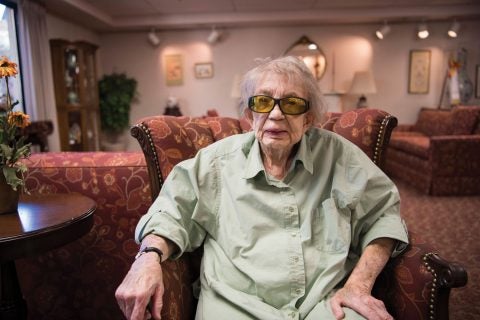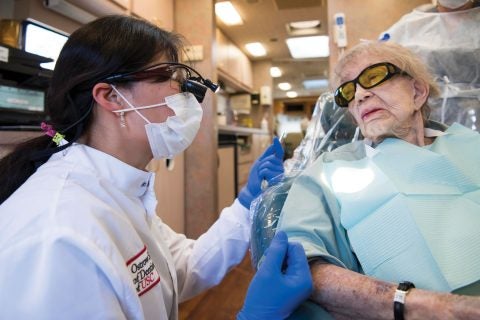Dental students gain valuable experience with burgeoning group: older patients
Older adults will soon outnumber children, and Trojans’ regular rounds with residents at the Hollenbeck Palms help them understand the complex needs of this growing population
The night before an important date with his wife, Norman Beals had a dental emergency.
“While I was eating, my two front teeth broke,” Beals recalled. “My wife and I were really disappointed, not so much for what happened to me, but because it would upset the plans we had, which were quite big.”
Beals, who recently turned 102, is a resident at the Hollenbeck Palms retirement community, which USC partnered with in 2001 to provide dental care to its residents.
“The dentist knew how upset we were, so she came in early the next day to see me,” Beals said. “I walked out of the [clinic] with two front teeth that looked as real as could be.”
Faculty and students at the Herman Ostrow School of Dentistry of USC have long provided comprehensive care for the elderly — both at Hollenbeck Palms, a nonprofit long-term care facility, and at the Dr. Roseann Mulligan Special Patients Clinic, which provides treatment for medically complex cases.
Dental care for elderly must be safe and specialized
Having a geriatric clinical rotation built into the curriculum gives USC dental students valuable, hands-on clinical experience with this ever-growing population.
The U.S. Census Bureau projects that by the year 2030, 1 in 5 residents will be older than 65, with older adults outnumbering children.
“Even though students might not specialize in geriatric dentistry, they are going to see elderly patients,” said Lisa Hou, director of the USC Mobile Dental Clinic at Hollenbeck Palms. “The entire population is aging, and it’s important to understand how to treat geriatric patients safely and effectively.”
During their fourth year, USC students are required to complete rotations at the Hollenbeck Mobile Dental Clinic and the Special Patients Clinic.
“As the population ages, there will be a greater need for dentists who are willing and able to treat these patients safely,” said Bianca Yau, who recently completed her rotation at Hollenbeck Palms. “It was important for me to gain some experience with this population, which needs more specialized care.
There’s no one-size-fits-all approach

Hollenbeck Palms is home to a range of patients: Some are independent and come and go as they please, while others require higher levels of care.
“Students see patients who need different modifications,” Hou said. “The ideal treatment might not work for an older patient, so it’s a lot of problem-solving based on patient history and within the limitations of the clinic itself.”
During their time at Hollenbeck Palms, students are paired up to see more able-bodied patients in the morning. Come afternoon, they often provide bedside care to residents at the Hollenbeck Palms’ skilled nursing facility.
“There’s so much attention to detail — how far to lean someone back in the chair or how loud I need to talk,” Yau said. “We learned how to transfer patients from a wheelchair to a dental chair — something you wouldn’t even think about until you have a patient in a wheelchair. It was really eye-opening.”
Students encounter patients with a range of medical issues from heart conditions to diabetes, and preparations can involve more than treatment modifications.
“If a patient’s diabetes isn’t controlled well, they could have an episode in the chair,” Hou said. “We try to teach students what to do if something like that happens.”
Older patients often take medications that can affect dental treatments, from prescriptions that cause dry mouth and affect dental hygiene to cardiovascular drugs that can interact with local anesthetics.
“There are so many new medications coming out that I can’t even keep track,” Hou said. “It’s more about making students aware of what they need to look at to treat a patient safely.”
While patients might share a particular medical condition, Hou stresses to students that there’s no one-size-fits-all approach when it comes to treatment.
“I think that in the past, we had a preconceived notion that all older adults were the same,” Hou said. “They all have missing teeth, and they all need dentures. That’s no longer the case. It’s important to look at the patient as a whole and see each individual’s needs, physically and emotionally.”
Overcoming past trauma

Gloria Schwed, a 95-year-old Hollenbeck Palms resident, is deathly afraid of the dentist. “When I was very young, 10 or so, a dentist pulled a molar without anesthetic,” she recalled. “Another dentist hit an artery in the roof of my mouth, and I lost eight cups of blood. I’ve had a rather difficult time.”
During certain treatments, which have included extractions and a partial, Schwed requested to be sedated, which can be complicated given her age.
Stephanie Alarcon, who treated Schwed at the Special Patients Clinic, used different techniques to treat Schwed safely and comfortably.
“Because her anxiety is so high, we’ve used an oral sedative, and that has worked really well,” Alarcon said. “We’ve also meditated with her, and that lowered her blood pressure significantly. It’s difficult for her to stay in the chair because she has back and shoulder pain, so using a pillow helps.”
Alarcon saw a change in Schwed’s demeanor during her most recent appointment.
“We took impressions, and Gloria was very pleasant. Afterward she said, ‘Oh that was easy,” Alarcon recalled. “I loved that appointment. I’ve been seeing her awhile, and I feel like we’ve developed a trust. I hope that continues.”
Schwed agrees that her anxiety has improved. “[The students] do their best to calm me and pay attention to my fears,” she said. “They’re just so friendly, and they go slowly, explaining each step.”
When it comes to being a good provider to the geriatric population, Hou said students must learn to consider more than patients’ dental and medical needs.
“You have to care about the patient and be empathetic.
Lisa Hou
“You have to care about the patient and be empathetic,” she said. “It’s about being a good listener.”
When Hou shows students around Hollenbeck Palms, the tour often includes a stop to chat with Beals.
“[Lisa] likes me, and she feels that I have an input that would be of benefit to the students she brings by,” he said. “They have treated me like a king, and at such a nice level, it’s like we’re buddies.”



